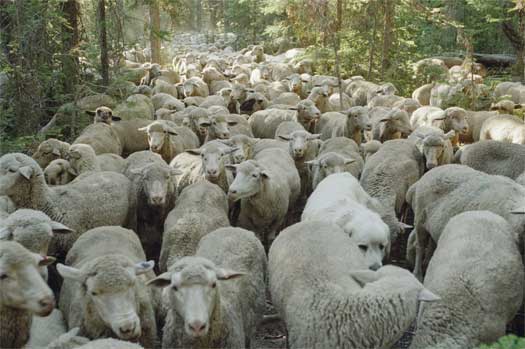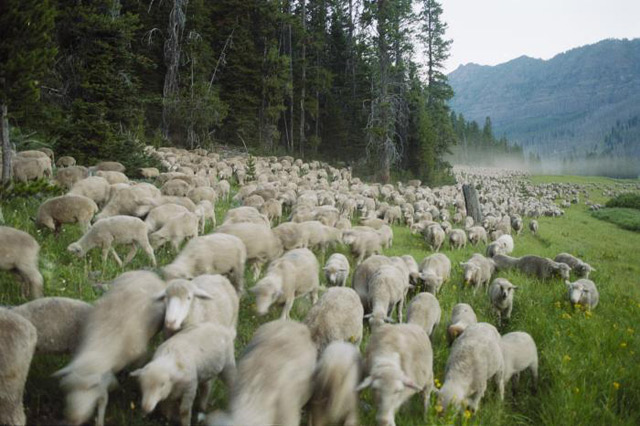
Baaa. Baaaa. Baaaaaaa. Baa. BAAAAAAAaaa. Baaaaaa. BAAAAAA! Baaaa….BaaaaAAA. BAAAAAA. baaaaa. baaaaAAAAA. Baaa. baaaAAAAA. baaaaaa. baaaaA. BAA. Baaaaa. baAAAAaaaaa. Baaaaaa. Baaa. Baaa. Baaa…BAAAAAAAAAA. baaa. (baaaaAA.) BAAAAAAA. BAAAAAAA! baa. baaaa. baaaaa. baaAAAA? BaaaAAAA? BAAaaaa. Baa. Baaaa. BaaaaaAA. BAAAAA. [Spoiler: Highlight to Read:] Baaaaaaaa!
And so on. Judging from the generally positive reviews, I went into Lucien Castaing-Taylor’s pretty but painfully slow sheepherding documentary Sweetgrass expecting a languid, contemplative rumination on the ancient but fading bonds between Man and Beast. And I guess that’s basically what I got. But, at the risk of seeming like a Philistine, trust me: You really can’t overestimate how slow-moving this picture turns out to be. Sweetgrass has images of undeniable beauty, sure, but I thought its reach far exceeded its grasp. And, while obviously different movies work for different people, some of the ridiculous praise Sweetgrass is getting — “the first essential movie of this young year,” for example (Manohla Dargis, NYT) — has a definite “Emperor’s New Clothes” feel to it.
Billed as “the last ride of the American cowboy” (as in Brokeback Mountain, by cowboy they mean sheepherder), Sweetgrass chronicles the final time a flock was taken into Montana’s Absaroka-Beartooth mountains for summer pasture on a federal grazing permit, in 2001. It seems like an arduous undertaking, and no mistake — Two men have to corral hundreds of sheep on a journey through forests, across creeks, and up and down steep mountainsides, with only some horses and a few dogs to help them. (Speaking of which, I imagine Berk would’ve loved this flick.) But, just because a job is hard doesn’t necessarily make it compelling for motion picture purposes. And, as a film, Sweetgrass loses the thread in them there hills.
The movie works best in its opening half-hour or so, when the long, uninterrupted takes of sheep and shepherd behavior still seem like a novelty. The herd is shorn, the herd is fed (from a big wheel of grass, basically), the herd reproduces, the herd is driven through the streets of a small town to start its great grazing adventure. All pretty interesting. But, once Swetgrass gets into the actual drive into the mountains, we’re already pretty much inured to strange sheep behavior and the crazy fluid dynamics of the herd, and there’s not enough other story to sustain the enterprise. So after awhile, you just sit there, waiting for something — anything! — to happen: Demon sheep? Killer sheep? Even just a Black Sheep, maybe? Nope, sorry. Instead, we sit through extended shots like “Sheep being Sheep,” “Man Getting on Horse,” “Man Setting Up Tent,” “Sheep Still Being Sheep,” “Man Eating Bacon,” “Sheep Even Still, Not Surprisingly, Being Sheep,” and “Man Complaining about Sheep Being Sheep.” (Yes, I was reminded of this Onion classic.) There’s not much there there.
I say “Man” because, in a Cormac McCarthy-esque flourish, the film never really introduces us to the two shepherds on this drive. Presumably, this was to add to the “ancient natural rhythms” feel of the film — man, dog, horse, and sheep engaged in a millennia-old ritual or somesuch. The problem is, neither of this pair are engaging or particuarly easy to relate to. (Earlier, a sheephand at the farm gets off a good joke about “cowboy brains,” but unfortunately he’s not on the Big Trip.) The elder fella on the drive has a certain whos-more-grizzled je-ne-said-quoi, I guess, but he’s a mumbler with a maddening tendency to repeat himself over and over and over again. (Did I mention he repeats himself? He repeats himself.) And the other guy, who gets less screen time, probably ends being even worse to hang around with. At one point late in the film, he throws what can only be called an epic hissy fit — screaming vulgarities at sheep and calling his mom to whine about his predicament. I get it, it sucks. You’re still on camera, buddy.
Speaking of getting it, I know what the counterargument to my dismissal here is — As the Boston Globe‘s Ty Burr puts it, Sweetgrass is arguably “about the death of a particular sense of time: slow, profoundly observant, in tune with the larger cycles of nature…If you’re used to the ADD pace of modern filmmaking, ‘Sweetgrass’ will probably drive you crazy. If you can adjust, it could widen your soul.” Well, ok, I plead guilty to ordinarily being a souped-up, Twitter-happy, multi-tasking, Red Bull achiever. And, when it comes to spending my entertainment dollar on discourses about the Death-of-the-West, I highly prefer Red Dead Redemption (or, for that matter, books like Richard White’s It’s Your Misfortune and None of My Own) to plodding docs like this. But I also feel like I have a higher-than-normal curiosity about the world, and I don’t think I have the attention span of a hummingbird either. And, despite my best efforts, I was just not feeling this film. To be honest, some of this “you can’t handle a slower rhythm” talk feels like an attempt to make Sweetgrass critic-proof.
As it is, Sweetgrass would’ve probably made for a great one-hour National Geographic documentary or an episode of Dirty Jobs. And, as a “thick-description” anthropological study of a sheep drive, it probably has its merits too. But, as a full-length movie, though, it leaves much to be desired. On the bright side, its glacial pace and studied solemnity actually sent me into 21 Grams-style chuckling fits after awhile, and everyone in the theater got a good laugh at the sheephands onscreen snoring in unison with the guy in the front row. Counting sheep, indeed.

